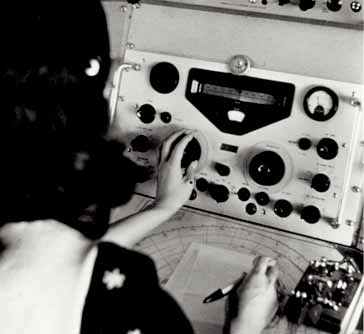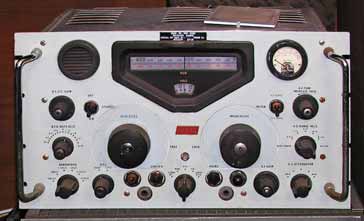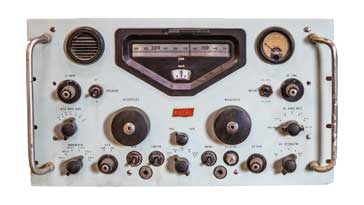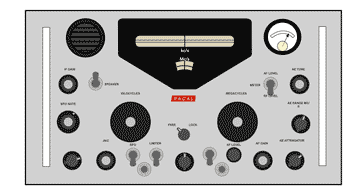Racal RA17: communications radio receiver
Launched in 1955, the Racal RA17 is an iconic vintage radio receiver that broke new ground in RF circuit design technology by using the Wadley Loop for frequency stability.
Racal RA17 Includes:
Racal RA17
How the RA17 was developed
RA17 technical description
RA17 specification
Iconic radio receivers:
Summary of iconic radio receivers
Radio receiver history
Crystal radio sets
Development of the superhet radio
Radio history / timeline
The Racal RA17 radio receiver provided a revolutionary improvement in performance when it was first introduced. Many now consider it to be a classic vintage radio.
Using a new scheme called the Wadley loop, the Racal RA17 virtually eliminated frequency drift - a problem that had dogged all previous radios.
As a result of its performance, the Racal RA17 was widely used for many forms of radio communications activities and monitoring on the HF radio bands.
Nowadays the RA17 can be seen in the vintage radio fairs where they are sought after by enthusiasts who enjoy using the technology.

Racal RA17 background
By the mid 1950s when the RA17 was introduced, single sideband transmission was starting to be adopted and for this much greater levels of stability were required.
Prior to the introduction of the RA17, previous radios had typically used a free running variable frequency oscillator. Vintage radios like the Marconi CR100 & CR150, AR88 of 1940s were still widely used and provided excellent performance in many other respects could not compete with the RA17.
Although free running variable frequency oscillators might be acceptable for low frequencies below about 3 or 4 Mc/s, as they reached frequencies towards the top of the range or 30 Mc/s or so, they would need to be periodically retuned, especially when receiving Morse or single sideband.

Courtesy RSGB
Some radios adopted the approach of using a fixed frequency first conversion down to a wide first IF and then using a non-switched variable frequency oscillator running at a low frequency for the second conversion. Although it produced a highly stable receiver, the first IF bandwidth was limited to around 500 kc/s maximum and this meant that a huge number of bands were required to cover even the HF bands.
The Racal RA17 used the Wadley Loop principle which cancelled out drift and effectively meant that the local oscillator frequency was "locked" to that of a crystal reference. This meant that the RA17 was streets ahead of the competition in terms of accuracy, bandspread and frequency stability.
However to achieve this, the RA17 used a triple conversion topology and this created some serious design challenges which were overcome to provide the high levels of performance that were needed.

How to tune the Racal RA17
in view of the very novel way in which the RA17 created its local oscillator signal, the tuning required the use of two controls - the two large tuning knobs on the front of the receiver.
The right hand tuning control was labelled "MEGACYCLES." This was set using the smaller frequency readout on the main dial assembly to the required frequency in Megacycles. In effect this acted like a band-switch selecting the required band in Megacycles.
The left hand tuning control was labelled "KILOCYCLES" and this was effectively the tuning control. This could be used to tune in the required station.
Once the required station had been selected, the Megacycles control could then be tweaked to give the optimum reception.

Racal RA17 topics
There are several key areas associated with the Racal RA17:
RA17 development story: The development of the RA17 can be traced back to an order that Racal secured when they hoped to manufacture the Collins 51-J under license in the UK.
This fell through and Racal was left with an order to build radios, but no design. Fortuitously Dr Wadley, inventor of the Wadley loop managed to interest Racal in his idea and then in 1953 development commenced, with the first receivers delivered in 1955. The radio was manufactured for many years, and thousands delivered.
Read more about . . . . RA17 Development Story.
RA17 circuit description: The Racal RA 17 had over 20 valves / tubes and used the Wadley loop system to provide the stability required. The radio was designed to provide a very high level of overall performance, and although some were able to look at its overall limitations, it was still able to compete very well with the best of the competition.
Read more about . . . . RA17 Technical & Circuit Description.
RA17 specification: The Racal RA17 boasts an impressive specification. It does not have all the remote control facilities and scanning capabilities of modern receivers, but even these days, it is able to perform well.
Read more about . . . . RA17 Specification.

Racal RA17 highlight features
The Racal RA17 is known for a number of its features. Obviously the main feature of this vintage radio is the very high level of stability for the time, but it also boasted many other impressive performance parameters.
Some of the highlights of the radio receiver are given below.
| Racal RA17 Highlight Features | |
|---|---|
| Parameter | RA17 Feature |
| Frequency coverage | 980kc/s - - 30 Mc/s (down to 500kc/s with degraded performance). |
| Local oscillator technology | Wadley Loop |
| Conversions | Triple conversion superhet |
| Reception modes | AM & CW - SSB adaptor became available |
| Antenna input impedance | 75Ω |
| Output impedance | 3Ω and 600Ω |
| Sensitivity and S/N ratio | 1µV for 18dB S/N (AM) 3µV for 18dB S/N (MCW) |
| Gain controls | RF & AF |
| AGC | Long and short |
| Dimensions | Width: 19 in (48.3 cm) Height: 10 ½ in (26.7 cm) Overall depth: 20 ⅛ in (51 cm) Depth behind panel: 18 ¾ in (47.6 cm) |
| Weight | 67lb (30.5kg) |
| Production availability | 1955 until at least 1967 |
Being based around thermionic valve or vacuum tube technology, and with a large number of valves, this classic vintage radio was very large and heavy. However this was normal for the time, and as most of the radios were sold to government type organisations and mounted in racks, this was not an issue.
it was only later with the introduction of transistors and integrated circuits that the size and weight of radios could be reduced without compromising their performance.
The Racal RA17 was one of the most successful post World War II HF communications receivers. It was installed in many UK government institutions as well as being extensively used by the BBC and many other organisations world wide. Thousands of the receivers were manufactured and sold, and it enabled Racal to establish itself as a major electronics company, which ultimately gave birth to the mobile phone company Vodafone, which even today is one of the largest in the world.
The RA17 was a milestone in the development of the radio receiver in view of its very high stability and many consider it to be a classic vintage radio.
 Written by Ian Poole .
Written by Ian Poole .
Experienced electronics engineer and author.
More History:
Radio history timeline
History of the radio
Ham radio history
Coherer
Crystal radio
Magnetic detector
Spark transmitter
Morse telegraph
Valve / tube history
PN junction diode invention
Transistor
Integrated circuit
Quartz crystals
Classic radios
Mobile telecoms history
Vintage mobile phones
Return to History menu . . .


